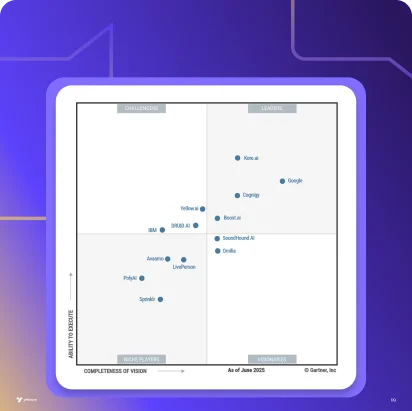In a rush and need the TL/DR version?
Summarize
Businesses increasingly rely on Customer Engagement Platforms (CEPs) to manage customer interactions across multiple channels. This blog explores top platforms, including Yellow.ai, Salesforce, Zendesk, Hiver, Help Scout, HubSpot, ServiceNow, Intercom, Drift, Helpwise, Kustomer, HappyFox, Front, Kangaroo, and Sprout Social, which help enhance customer engagement and drive business growth through personalized experiences.
Key benefits and operational mechanisms of Customer Engagement Platforms:
- Unified customer interactions: CEPs consolidate interactions across various channels like email, social media, and live chat, ensuring a seamless customer experience and reducing communication silos.
- Enhanced customer support: They automate responses and streamline customer service processes, enabling 24/7 support, which is crucial for maintaining high customer satisfaction levels.
- Personalized engagement: CEPs analyze customer data to deliver personalized marketing messages and product recommendations, enhancing the overall customer experience and increasing engagement.
- Operational efficiency: By automating routine tasks, CEPs free up staff to focus on more complex inquiries, improving productivity and reducing operational costs.
- Real-time analytics: They provide essential insights into customer behavior and preferences, helping businesses make informed decisions and tailor their strategies accordingly.
- Customer retention: Through proactive engagement and consistent experience across all touchpoints, CEPs help build loyalty and reduce churn.
- Scalability: CEPs can easily scale to accommodate growing interaction volumes without compromising on the quality of customer service.
- Workflow automation: They automate workflows for actions triggered by customer behaviors or preferences, ensuring timely and appropriate engagement without manual intervention.
Yellow.ai distinguishes itself among customer engagement platforms with its powerful AI-driven features. Providing contextual, real-time insights significantly enhances the effectiveness of customer service teams. Its ability to deliver consistent, personalized interactions across all customer touchpoints ensures a seamless experience that drives customer satisfaction and loyalty.
Note: This summary is not a substitute for reading the article in full, as you may miss out on important nuances.
Customer engagement platform or CEP is vital for businesses aiming to interact and engage with their customers seamlessly across various touchpoints. It is also called customer engagement software. By leveraging a digital customer engagement platform, enterprises can enhance customer satisfaction, streamline operations, and drive growth. In today’s omnichannel world, customers expect fast, personalized service, meaningful marketing, and smart recommendations on their preferred channels—phone, email, social media, live chat, SMS, and messaging apps. A brand that can keep its customers engaged, earns their loyalty, social proofing and public image. An effective CEP also helps achieve customer service automation effortlessly.
It is a powerful software tool even for managing complex customer relationships. The purpose of an effective CEP is achieved, for instance, when a business exhibits its sincere attempts to engage, hear, and understand even an irate customer. This blog explores the importance of customer engagement platforms, their role in modern businesses, and some of today’s leading customer engagement solutions. Read on for actionable insights into picking the right one and optimizing your customer engagement software to your tailored goals and needs.
What is customer engagement?
Customer engagement refers to the sum of clients and buyers’ interactions with that company over time and across different customer communication channels including email, social media, community forums, etc. Without buyer engagement, relationships with consumers don’t flourish. Focusing on your target audience and their demands is key to customer engagement. It highlights a customer’s emotional connection or bond with a company or brand. While related, customer engagement is not necessarily:
- Customer experience — the many points of contact and interactions between a company and its customers.
- Customer support refers to the assistance a business offers to customers to optimize their use of a product or service.
- Through outreach, education, and advocacy, businesses may increase customer success by making the products more satisfying and beneficial.
The aforementioned affect customer engagement, but they don’t determine it. After all, being satisfied with a product doesn’t necessarily mean following the company that makes it on social media or feeling a sense of loyalty toward the brand.
So, how can you boost customer engagement?
Successful customer engagement involves personalizing consumer experiences and interactions.
- This personalization is not just about addressing them by their name
- You must truly understand their preferences and needs
- Learn about your customers—who they are, how they communicate, connect with your product and organization, and their beliefs and motivations.
This is when modern digital customer engagement platforms and tools can provide your business with the data required to better understand and interact with our customers.
What is a customer engagement platform?
A customer engagement platform is advanced software designed to streamline and enhance interactions between businesses and their customers across multiple channels. It helps businesses interact with customers, gather feedback, provide support, and improve customer relationships. According to Forbes, CEP serves a worldwide purpose: to provide a uniform and effective strategy to sustain a lifelong customer relationship. And a modern business in the era of digital customer service can’t survive without a CEP in the long run. A Futurum Research survey in collaboration with Microsoft, states that 85% of businesses say their clients are substantially more digital than expected.
Customer engagement software integrates various customer engagement tools, providing a unified interface to manage communications via phone, email, social media, live chat, SMS, and messaging apps. Such flexible communication and automation tools for common actions and frequent responses result in more timely and quick responses. They also integrate with other customer-centric systems and offer robust analytics and insights, enabling companies to better understand and track customer behavior and preferences, optimize tailored interactions, and drive growth. 90% of businesses believe their current client journey tracking methods need an upgrade. By leveraging sophisticated customer engagement software, businesses can deliver personalized, timely, relevant experiences, fostering deeper customer relationships and loyalty.
Let’s delve into some of the top customer engagement tools in today’s technological realm:
- Help desks & shared inboxes
- Social media management software
- In-app & web messaging platforms
- Live chat products
- Chatbots
- Knowledge bases
- Feedback & survey tools
- Email marketing software
- Loyalty programs & platforms
- Reporting and analytics tools
- A/B testing platforms
- Customer segmentation tools
- Customer relationship management (CRM) systems
- Video conferencing platforms
Key features of a customer engagement platform
A few features collectively make customer engagement software a vital tool for businesses striving to optimize customer interactions and drive growth. According to 88% of participants in Microsoft research, they anticipate modifying their customer engagement practices to conform to upcoming market and regulatory demands. Let’s explore 10 such features.
1. Unified customer profile
Consolidates data from different sources to create a comprehensive view of the customer, including demographics, purchase history, interaction records, and preferences.
2. Omnichannel integration
Provides a seamless experience across multiple channels, ensuring consistent interactions via social media, email, web chat, SMS, and in-app messages. This omnichannel customer engagement helps businesses to deliver excellent customer service.
3. Automated workflows and campaigns
Enables businesses to set up triggers based on customer criteria, ensuring timely and relevant interactions without manual intervention.
4. Feedback collection and management
Facilitates understanding of customer feedback and sentiment through tools like surveys, feedback forms, and direct interactions.
5. Self-service capabilities
Offers knowledge bases, chatbots, and other self-help resources, empowering customers to resolve queries independently.
6. Security and compliance
Ensures stringent security measures, including encryption and access controls, and compliance with data protection regulations.
7. Engagement analytics
Tracks customer engagement to reveal preferences, challenges, and trends, enabling quick, informed actions and satisfaction-boosting strategies.
8. Automation
Automates tasks such as responding to emails or web chat queries and providing customers with immediate responses.
9. Customer journey orchestration
Guides customers through the entire lifecycle, fostering brand loyalty by ensuring consistent assistance.
10. Customizable dashboards
Allows the creation of personalized dashboards to monitor key performance indicators (KPIs) and track engagement strategy effectiveness.
What is the importance of customer engagement platforms?
A customer engagement platform’s importance lies in its benefits to businesses in keeping pace with rapidly evolving customer expectations. This powerful tool has countless advantages for creating loyalty and fostering lasting customer relationships. Here’s why a customer engagement platform is essential:
Better customer experience
A customer engagement platform empowers businesses to deliver personalized messages across preferred communication channels, ensuring customers receive the right message at the right time and enhancing their overall experience.
Emotional connections
With a CEP, an enterprise can engage with its customers through their preferred channels and create strong emotional ties. These connections increase customer satisfaction, boost sales, and improve retention rates.
Ease of communication
Digital customer engagement platforms integrate various communication channels. With it, you can extend a seamless and consistent experience to your customers across social media, email, SMS, and more. This ensures customers can interact effortlessly with the brand, no matter the platform.
Foresighted customer support
With advanced customer engagement solutions, businesses can proactively address customer needs, solve issues before they escalate, and provide timely assistance. This results in earning trust and loyalty.
Marketing opportunities
Customer engagement software offers powerful tools for marketing teams to discover new customers and deepen relationships with existing ones.
Top 15 customer engagement platforms for 2024
Top 15 customer engagement platforms for 2024
- Yellow.ai
- Salesforce
- Zendesk
- Hiver
- Help Scout
- Hubspot
- ServiceNow
- Intercom
- Drift
- Helpwise
- Kustomer
- HappyFox
- Front
- Kangaroo
- Sprout Social
Yellow.ai
Powered by Generative AI, Yellow.ai directly connects consumers to brands, enabling timely, personalized, omnichannel engagements and enhancing interactions across the lifecycle. With consumers’ expectations evolving everyday, brands must adopt a customer-first approach, engaging throughout the buying journey with meaningful, personalized conversations. Yellow.ai’s platform maximizes ROI from marketing efforts by generating high-quality leads, boosting conversions, increasing share of wallet, and providing a 360-degree user profile, all while cutting costs by 60%. Using goal-based conversations, Yellow.ai’s AI agents can engage customers and nudge them towards a specific business goal that the brand has in mind- be it for lead generation, increasing conversions, receiving customer feedback and more.
Key highlights
- 60% increase in customer engagement: Create AI powered conversational templates to engage with customers across channels.
- 30% decrease in cart abandonment rates: Grab a user’s attention with proactive nudges across channels.
- 10% increase in net revenue: Identify purchase patterns, intent, and sentiment and run campaigns to increase average order value and reduce churn.
- Over 100+ integrations: Integrate with ecosystem leaders in CRM and Ticketing, Inventory/Order Management, Payments, Logistics, Marketing, Contact Center Solutions. It also has 150+ pre-built templates.
- 90% inbound query automation: Trained on 16B+ conversations annually, Yellow’s bot platform automates 90% of incoming queries with human-like empathy.
- Enterprise-grade security: With Yellow.ai your enterprise is highly secured as it is an ISO, HIPAA, SOC2, and GDPR certified platform.
Salesforce
Salesforce Customer 360 extends Salesforce’s expansive toolkit to provide a comprehensive customer perspective. It aggregates data on each customer’s interactions, purchases, preferences, and feedback to help organizations understand and meet consumer demands.
The main characteristics include a single customer view, which collects data from several touchpoints. Create personalized customer journeys using AI to boost engagement and satisfaction. Integrate and Scale: Flexible and scalable integration with Salesforce and third-party apps.
Zendesk
Zendesk customer engagement software works as an omnichannel communications platform known for its customer support tools. It allows teams to manage service requests across various channels, such as email, live chat, voice, SMS, and social media.
Zendesk offers customizable help centers, community forums, and the Answer Bot chatbot for instant customer answers. Beyond support, Zendesk offers sales teams plans with customizable sales pipelines, email management, calendar integration, task tracking, sales forecasting, and goal tracking. These plans are built on Zendesk Sunshine, a CRM platform consolidating customer information. However, setting up and maintaining Zendesk can be challenging, making it a better choice for enterprise companies with the necessary development resources. It also offers a free trial.
Hiver
Hiver customer engagement platform enables businesses to use Gmail as a central communication hub, allowing them to engage with customers on various channels, such as email, chat, phone, knowledge base, and WhatsApp. It is easy to set up and offers white-glove onboarding for all users.
Hiver transforms emails into actionable tasks, assigning each query or request to a dedicated team member, ensuring accountability and visibility. It uses smart routing to distribute incoming customer messages to the most suitable team or individual, leading to faster and more accurate responses. By using it, businesses can establish a knowledge base and it gives extensive performance analytics and pre-written templates for speedy customer service.
Help Scout
Help Scout is a customer support platform that prioritizes personalized conversations between businesses and their customers. It focuses on genuine conversations rather than ticket numbers and automated replies. It organizes customer questions, concerns, and feedback under one roof, enabling support teams to provide timely and relevant responses.
The main features are Docs Knowledge Base, which gives clients self-service to discover answers fast, and Beacon, an on-site chat, search, and knowledge base solution for real-time customer service. Reports offer extensive insights into team performance, discussion volumes, and customer satisfaction to improve engagement tactics.
HubSpot
Hubspot’s CRM Suite manages and improves business-customer connections. It records all consumer contacts, regardless of channel. This data helps organizations understand client preferences and how to reach and serve them.
Businesses may use the Contact Management tool to track every customer and prospect encounter and feed engagement plans. Likewise, its Marketing Automation uses user behavior to tailor campaigns. Conversation Inbox centralizes emails, chats, and more to provide teams with complete context throughout client interactions.These systems effectively track and analyze user data, which informs product planning, marketing optimization, and data-driven decision-making to boost consumer engagement.
ServiceNow
The ServiceNow customer engagement platform is a ticketing tool primarily used for IT service management. IT teams may process, categorize, and handle incidents, updates, and other issues using it. Features may be examined to determine its customer engagement platform efficacy.
Examples include Agent Workspace for case management and omnichannel assistance, “Customer Central” for information cards, self-service with knowledge base management, and communities. The mobile agent interface allows agents to triage, handle, and answer inquiries on the move and interact with third-party applications like CTI software and platforms.
Intercom
Intercom is a popular engagement platform that sales and marketing teams use to engage with customers through in-app messaging, chat conversations, and surveys. It has recently added customer support features like a shared inbox and knowledge base builder, making it an ideal choice for full-service customer communications. Beyond standard tools, Intercom allows users to create code-free product tours and in-app tooltips, making it ideal for teams with limited developer resources.
Users can create custom chatbots for automated issue resolution and chat with customers in multiple languages. However, Intercom’s features are part of higher-tiered plans, making it suitable for enterprise teams but not for smaller budgets.
Drift
Drift as CEP focuses on conversational marketing, sales, and support. It offers live chat, video, and email conversations. Drift also supports self-service chatbot processes and third-party knowledge-base software interfaces.
Drift’s web widget can be installed on any page on your site, allowing your team to capture customer and lead information, deliver targeted messaging, and provide proactive support. This CEP offers a landing page builder, in-app meeting scheduling, and reporting dashboards. Drift’s engagement score is a metric provided to subscribers, recalculated every 30 minutes based on touchpoints like meetings, conversations, videos, and email clicks. Despite its robustness, Drift is on the pricier side of conversational software, with a free plan mentioned but unclear.
Helpwise
Helpwise has grown from its original form as a shared inbox tool to currently combining all client discussions in one spot. Email, text messages, WhatsApp, social media, and live chat are some ways team members may manage their messages from a central inbox.
Among its notable characteristics is that although inboxes are shared, each user has his own password to ensure more security and boost efficiency. Use the shared inbox to tag, assign, and talk with teammates. Integrations include Dropbox, Agile CRM, Trello, and Zoho CRM. It paves the way for integration with business tools that automate workflows and measure metrics.
Kustomer
Kustomer CRM focuses on businesses, especially those engaged in direct-to-consumer (DTC) sales. The platform unifies customer experience with email, phone, chat, social, and messaging app capabilities.
Kustomer lets your support staff use its “Unified Customer View” ticketing option. It is compatible with several contact center platforms, allowing your agents to easily handle chatbots and omnichannel interactions. Feature highlights include cloud-based CRM, customisable messaging, enhanced CRM controls, and chatbots for cross-channel communication.
HappyFox
HappyFox offers omnichannel assistance for contact centers and is an all-inclusive help desk software for companies of any size. However, for complete omnichannel aid, including phone calls, HappyFox must integrate with a cloud contact center solution. Apart from tickets, HappyFox offers live chat, chatbots, AI, and workflow automation.
Omnichannel ticketing, seamless multilingual self-service support, workflow automation with customizable smart rules for escalation and ticket reassignment, real-time customer support metrics, customizable reporting for inflow, agent activity, performance, CSAT, and more are some of its key features.
Front
Front provides a common email mailbox to your customer-facing staff and they can address issues faster and improve digital customer experience with its multichannel messaging support and analytics tools.
Automatic message sorting and prioritization, customizable message templates to automate tedious tasks, email threads, shared drafts, and team inboxes for easy collaboration, and organizing tasks with team member assignments are among the features. It also has analytics tools for the team, agents, and customer messaging, API connections to gather customer database centrally, and omnichannel support for social media, live chat, and email
Kangaroo
Kangaroo is a loyalty and rewards platform encouraging positive customer behavior through gamification. It offers a tiered pricing plan with additional features like reward points, coupons, referral campaigns, social sharing rewards, eGift cards, and raffles. Higher-tiered plans include email and SMS marketing.
Kangaroo provides reporting to optimize campaigns and understand existing customer behavior. It integrates with eCommerce and POS systems, making it easy to enroll and reward customers. It also offers a free trial.
Sprout Social
Sprout Social, a customer engagement platform, automates workflows and lets users develop conversational chatbot experiences using an intuitive bot builder. It allows users to manage several social media accounts from a centralized location. It gives shared customer records, conversation history, customizable views, and real-time indicators.
The platform integrates with various platforms like Facebook, Instagram, LinkedIn, Pinterest, and more. As a CEP, Sprout Social offers features like a smart inbox, content planning, reviews management, and advanced analytics. The message spike alert feature notifies users when inbox messages or @mentions surge, potentially indicating a brand crisis that needs to be addressed to retain loyalty.
How does a customer engagement platform work?
A customer engagement platform works as an all-inclusive software which helps businesses track, manage, and enable interactions with their prospects and existing customers. It functions like a command center tracking and handling customer engagement with the enterprise. It integrates with customer engagement tools, such as:
- Direct messaging
- Chatbots
- Self-service
- In-app
- Virtual voice assistants and more.
It gives you access to all of your communication channels and engagement tools, which you can then utilize to create automated, omnichannel workflows. Thus, you can control and activate these processes without ever leaving your platform.
Visualize a disjointed customer experience: web signup followed by a mobile app push for a non-existent app, then a late delivery with a web survey and desktop coupon. This fragmented approach might seem a relic of the past, but it still exists in certain businesses’ customer service. Modern CEPs facilitate omnichannel workflows.
For example
Jenny Williams, a new food delivery app user, signs up on a desktop but doesn’t download the app. After a late delivery, a CEP triggers an SMS offering a discount coupon and a download link, letting her use the in-app coupon. Jenny downloads the app, fostering a positive mobile experience.
User actions (or inactions) across touchpoints trigger targeted responses through integrated tools – email automation, call masking APIs, surveys, and in-app notifications. Previously, siloed functionalities like SMS and voice calls have become unified within the CEP. This eliminates data fragmentation and fosters seamless customer journeys.
Difference between a CRM System and a Customer Engagement Platform
Customer Relationship Management (CRM) systems and Customer Engagement Platforms (CEPs) are often confused as they deal with customer interactions. However, understanding their differences is crucial for businesses opting for a customer engagement platform. While CRMs focus on managing customer data and sales processes, customer engagement platforms offer a broader scope, encompassing all customer interactions across the entire journey. Let’s have a look at the table below to understand their distinct characteristics between the two.
| Aspect | CRM | CEP |
| Primary focus | Manages the business’s interactions with current and potential customers. | Manages and enhances all customer interactions throughout the customer lifecycle. |
| Scope | Focuses primarily on sales, marketing, and customer service processes. | Covers the entire customer journey, including awareness, consideration, purchase, retention, and advocacy. |
| Data utilization | Emphasizes collection and analysis of historical data. | Utilizes both historical and real-time data to predict future behavior and personalize interactions. |
| Integration | Centralizes customer and prospect information for sales and marketing teams. | Provides an omnichannel approach, integrating interactions across web, mobile, social media, and in-person channels. |
| Proactivity | Primarily reactive, responding to historical interactions and data. | Both reactive and proactive, engaging customers based on real-time insights and predictive analytics. |
Improve your customer engagement with Yellow.ai
Customer engagement covers the entire customer lifecycle, from marketing to sales to customer support. To boost your customer experience, you must have the right customer engagement software and tools. This is when Yellow.ai comes in handy; your business can leverage its robust AI solutions to automate mundane and repetitive tasks, freeing your agents to focus on more complex issues. Yellow.ai emerges as a suitable pick with its USPs:
- Contextual, real-time insights, enhancing the customer service team‘s effectiveness
- Consistent, personalized interactions across all touchpoints
- Driving customer satisfaction and loyalty through quick yet effective and uniform responses
Transform your customer engagement with Yellow.ai
Summing up: Customer engagement platform and its importance in 2024
Forbes claims that acquiring new clients costs 5X more than retaining existing ones, emphasizing the need to keep existing customers satisfied and engaged and gain their brand allegiance. Devoted customers are assurances for steady sales and growing revenue for your business. This is where the critical role of a customer engagement platform emerges as a non-negotiable investment. With it in your arsenal, you can keep your current customers engaged, avoid churn, and attract new ones through the formers’ positive social proofing.
As we look forward, businesses striving to excel in customer service can craft user engagement programs that immediately turn even new customers into loyal ones by selecting the most suitable customer engagement platform. You can zero in on the right CEP by analyzing the features, pricing, integration compatibility, and desired goals.
FAQs- Customer engagement software
How does a customer engagement platform improve customer service?
A customer engagement platform (CEP) improves customer service by providing personalized, seamless interactions and service across channels. Businesses that invest in customer engagement tend to provide a positive customer experience, which boosts customer satisfaction and retention and can usher in improved customer loyalty and repeat business. Your CEP platform, which has omnichannel interaction and trustworthy AI and data, will boost the customer experience even more. AI with your CEP creates a robust virtual assistant to help agents work faster.
How do I measure the success of a customer engagement platform?
Businesses can measure the success of their customer engagement platform by tracking a combination of adoption, satisfaction, business impact, and operational metrics. It will also help them to identify areas for improvement. For example, adoption and engagement metrics can keep a tab on:
Number of active users: Track the number of customers actively using the platform over time
User engagement: Keep a tab on login frequency, platform time spent, and content engagements
Adoption rate: Calculate the percentage of targeted customers who have adopted the platform
Reviewing these indicators while executing data-based choices may assist in enhancing platform performance.
What types of businesses can benefit from a customer engagement platform?
Different types of businesses, such as retail, e-commerce, hospitality, banking or any enterprise with a high volume of customer interactions, can benefit from customer engagement software. These platforms are versatile. Nevertheless, their relevance can vary depending on the industry. Small businesses can profit immensely from such platforms, not just the megacorps. By using them, enterprises can understand their customer needs better, improve support quality and engage customers more effectively. Above all, these platforms provide a low-cost alternative for small firms.
How does a customer engagement platform handle customer data?
A CEP collects data from several tools in real-time. It unifies data into customer profiles and sends this data to marketing, sales, customer support, and analytics tools. Since it handles such critical customer data, it involves privacy concerns. Businesses must ensure that the platform complies with relevant data protection regulations and maintains transparent data practices to protect customer privacy.
Can customer engagement platforms automate customer communication?
Customer engagement platforms can automate customer communication besides helping your business automate different processes and campaigns. An example can be automating responses to inbound emails from customers or potential buyers for routine queries. Likewise, you can set up automated workflows for lead nurturing, customer onboarding, and feedback collection, ensuring consistent and timely customer communication.
What should I consider when choosing a Customer Engagement Platform?
When choosing the best customer engagement software, consider your company’s size, your industry’s unique demands, and the channels your consumers utilize. Also, evaluate the integration possibilities with your existing systems, simplicity of use, scalability, and cost.
What is the role of AI and machine learning in Customer Engagement Platforms?
AI and ML have an essential role to play in customer engagement platforms. AI revolutionizes customer engagement, offering personalized experiences, improved communication, and enhanced customer loyalty. AI and ML enable customer engagement platforms to segment customers on the basis of several attributes like the latters’ purchasing behavior, patterns, preferences, demographics, and interactions. Businesses may use this segmentation to generate focused marketing campaigns, tailored promotions, and unique products or services.





















